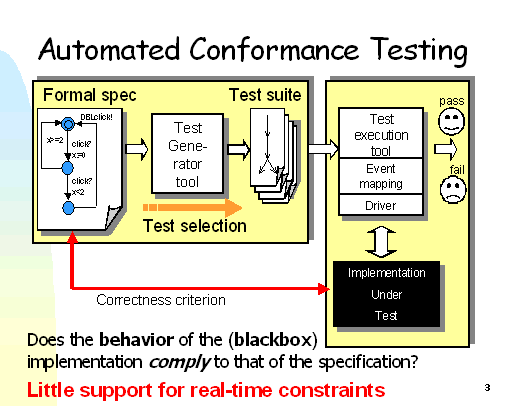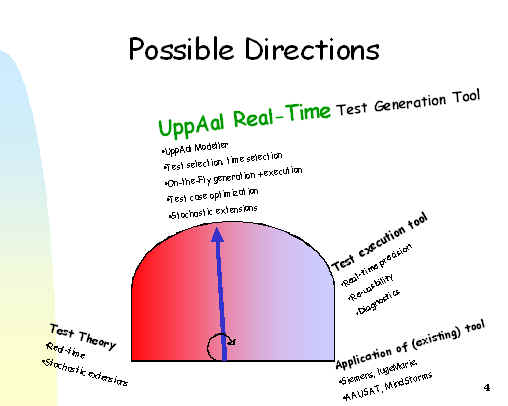HTML clipboardAutomatic Testing
Automated test generation consists of computing a set of
experiments/scenarios/test cases which can be used to determine wheter the
implementation behaves correctly. Test execution consists of applying
the experiment to the implementation, i.e. supplying inputs and checking the
outputs. Ideally, testing is completely automatic after the specification has
been given.

The DSS unit has a broad expertise in specification, analysis,
construction of real-time systems. We are therefore emphasizing the specific
real-time problems ranging from analysis of formal specifications to realisation
of systems using hardware and real-ime operating systems. Kim's expertize is on
algorithms and tools for analysis of real-time systems. Brian's is on real-time
testing (phD Thesis on the subject) and construction of real-time systems.
Within the context of automated testing we offer a wide spectrum
of possible projects, ranging from the highly theoretical to the highly
practical and constructive. Also a single project may consist of ingredients
from each aspect.

-
Construction of a real-time test generation
tool based on UppAal
Real-time tests must define precisely when an input to the system should be
generated and when a response should be expected. The time requirements will
be given as timed automata (formal model of real-time UML) specifications.
The UppAal verfication engine and underlying algorithms and datastructures
(zones) can also be adapted to generate test cases
-
A promising approach to test large systems effectively
is to use on-the-fly testing. Here the IUT and Uppaal are interconnected
(output events from Uppaal are connected to input events of the impl,
and vice versa, and the timed automata model is executed/simulated in
REAL-TIME to produce input events (event type and time where event
should be supplied) for the impl and compute "expectancies" for outputs
(event type and deadline where event must be received). This procedure
is repeated an extreme number of times to produce test sequences of
literally 100.000 + events. It is a thesis that this approach will be
able to handle very large specifications (avoid state space explosion)
and achieve good coverage. There are some indications that this approach
is a HIGHLY EFFECTIVE Stress testing technique.
-
Test generation strategies. Intuitively, the more
optimal test cases wrt. e.g. fewest possible, fastest total execution
time, minimal cost, highest coverage,, etc that are to be generated,
the more computations and computation time is required apriory by the
generation tool. But other times it is more important to handle very
large specs or generate test events very fast. Several compromises
between computing test events fast and computing optimal test sequences
exists.
-
Post-mortem analysis: In one extreme one may simply
blindly or randomly generate an input sequence without having the
faintest idea of how the impl should react. The sequence is executed
and the outputs from the impl is logged. After execution it is
checked against the spec wheter the impl responeded correctly.
-
On-the-fly: The specification is
interpreted/executed dynamically and valid test sequence are
computed.
-
On-the-fly with precomputed data structures: To
optimise speed, many manipulations of the specification have been
performed before test generation starts to produce data structures
containing answers/results/information that will be needed during
execution.
-
An optimal test suite is produced befor execution of
any test case starts.
-
What kind of TA specifications should be accepted?
Open/closed specifications? Modeling of environment assumptions? How
are test cases generated? How can the UppAal Engine be adapted to test
generation? How to select test cases? How to select the time instances
where inputs should be delivered and outputs expected.
-
A Real-Time Test Executive
Automated test execution requires that a test computer (or test software)
can communicate with the implementation under test, send and receive byte
sequences representing abstract events. A main problem in testing of hard
real-time systems is the timeliness of the test execution. The communication
delay from the test interpreter until the event is delivered at the
implementation interface (and vice versa) must be bounded, and preferebly
low overhead. This uncertainty must be measured. Also the events must be
precisely timestamped and logged, and the timestamps must be relayed to the
test interpreter/generator to ensure that correct verdicts are given, and
that generation of future event predictions are precise and valid. This
requires real-time support from the OS (predictable scheduling, memory
locking, ...) How good can this be done on of-the-shelf OS's like (win2k,
Solaris, ) and on specialised Real-Time Operating Systems.
Another main problem is that instrumenting the implementation and developing
the required communication are very time consuming. Therefore we seek an
efficient, general, reusable layered arcitecture based tool for test
execution. Other problems includes:
-
real-time testing: How to execute the test in a timely
precise manner? Implementation on a RT-OS.
-
pseudo real-time testing: Sometimes real-time takes too
long. How can (faithful) time leaps be added to allow for faster test
execution?
-
greybox testing: How to interrogate the implementation
about state information that can help the test tool/engineerer.
-
generation of diagnostic information: A fail verdict
alone is not very helpful. Why did the implementation fail? Where? Why?
Reprodicability?
-
Application of automated testing
A final option is to take an existing test generation tool (E.g. TorX
developed at Twente) and apply it to an industrial application to evaluate
the effectiveness and limitations of the tool. If you choose this direction
you will work with a very interesting application domain. The scientific
purpose is twofold: 1) It will demonstrate the effectiveness of automated
testing to industrial partners, and 2) it will generate ideas for new
desired functionalities, improvements, methods of circumventing its
limitations. Applications could be
-
AAU-Student Sattelite (a sattelite to be constructed
essentially by students only)
-
Advanced communication protocols (e.g Siemens Mobile
Phones)
-
Control software in "LugeMarie"
-
Lego Mindstorm robots
-
Probablistic testing at Lyngsų Industries.
-
-
Development of a real-time testing theory
An implementation relation is the correctness criterion used in automated
testing defining what it means for an implementation to be correct with
respect to a given specification. It is usually modelled formally as a
mathematically defined relation between two formal objects like two labeled
transistion system. It describes precisely what behaviors of the
implementation are acceptable compared to a given specification. A good
implementation relation is very important in practice because we neither
wish to accept an implementation which does not really work, nor rejct an
implementation that actually works. Formulation of an implementation
relation cannot be done without a glimse at practical considerations about
observability of the implementation and test execution realities: for
instance, we may not be able to meassure precisely at what time instant an
event occured but only within some bounds. Clearly, a theory requiring exact
timing is imperfect. An implementation relation for real-time systems do not
exist.


 Active Topics
Active Topics  Memberlist
Memberlist  Calendar
Calendar  Search
Search 
 Active Topics
Active Topics  Memberlist
Memberlist  Calendar
Calendar  Search
Search 



 Topic: Automatic Testing
Topic: Automatic Testing IP Logged
IP Logged

 Posted: 14Sep2009 at 12:28am
Posted: 14Sep2009 at 12:28am IP Logged
IP Logged

